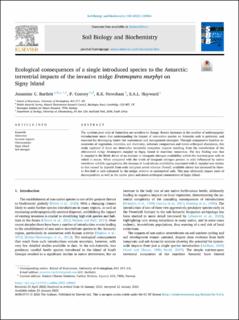| dc.contributor.author | Bartlett, Jesamine | |
| dc.contributor.author | Convey, Peter | |
| dc.contributor.author | Newsham, Kevin K. | |
| dc.contributor.author | Hayward, S.A.L. | |
| dc.coverage.spatial | Signy Island, Antarctic | en_US |
| dc.date.accessioned | 2023-09-27T12:20:08Z | |
| dc.date.available | 2023-09-27T12:20:08Z | |
| dc.date.created | 2023-03-15T18:08:47Z | |
| dc.date.issued | 2023 | |
| dc.identifier.citation | Soil Biology and Biochemistry. 2023, 180 . | en_US |
| dc.identifier.issn | 0038-0717 | |
| dc.identifier.uri | https://hdl.handle.net/11250/3092419 | |
| dc.description.abstract | The nutrient-poor soils of Antarctica are sensitive to change. Recent increases in the number of anthropogenic introductions mean that understanding the impact of non-native species on Antarctic soils is pertinent, and essential for developing future risk assessments and management strategies. Through comparative baseline assessments of vegetation, microbes, soil chemistry, substrate composition and micro-arthropod abundance, this study explored if there are detectable terrestrial ecosystem impacts resulting from the introduction of the chironomid midge Eretmoptera murphyi to Signy Island in maritime Antarctica. The key finding was that E. murphyi is the likely driver of an increase in inorganic nitrogen availability within the nutrient-poor soils in which it occurs. When compared with the levels of inorganic nitrogen present in soils influenced by native vertebrate wildlife aggregations, the increase in local nitrate availability associated with E. murphyi was similar to that caused by deposits from seals and giant petrel colonies. Overall, available nitrate has increased by threeto five-fold in soils colonised by the midge, relative to undisturbed soils. This may ultimately impact rates of decomposition as well as the native plant and micro-arthropod communities of Signy Island. Antarctica Invasion impacts Chironomidae Signy Island Soil nitrogen | en_US |
| dc.language.iso | eng | en_US |
| dc.rights | Navngivelse 4.0 Internasjonal | * |
| dc.rights.uri | http://creativecommons.org/licenses/by/4.0/deed.no | * |
| dc.subject | Antarctica | en_US |
| dc.subject | Invasion impacts | en_US |
| dc.subject | Chironomidae | en_US |
| dc.subject | Signy Island | en_US |
| dc.subject | Soil nitrogen | en_US |
| dc.title | Ecological consequences of a single introduced species to the Antarctic: terrestrial impacts of the invasive midge Eretmoptera murphyi on Signy Island | en_US |
| dc.title.alternative | Ecological consequences of a single introduced species to the Antarctic: terrestrial impacts of the invasive midge Eretmoptera murphyi on Signy Island | en_US |
| dc.type | Peer reviewed | en_US |
| dc.type | Journal article | en_US |
| dc.description.version | publishedVersion | en_US |
| dc.rights.holder | © 2023 The Authors | en_US |
| dc.subject.nsi | VDP::Zoologiske og botaniske fag: 480 | en_US |
| dc.subject.nsi | VDP::Zoology and botany: 480 | en_US |
| dc.source.volume | 180 | en_US |
| dc.source.journal | Soil Biology and Biochemistry | en_US |
| dc.identifier.doi | 10.1016/j.soilbio.2023.108965 | |
| dc.identifier.cristin | 2134258 | |
| dc.relation.project | Norges forskningsråd: 323304 | en_US |
| dc.relation.project | Andre: e Natural Environment Research Council (NERC) | en_US |
| dc.source.articlenumber | 108965 | en_US |
| cristin.ispublished | true | |
| cristin.fulltext | original | |
| cristin.qualitycode | 2 | |

